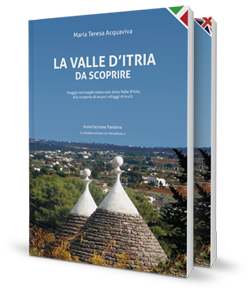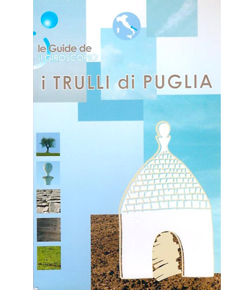Text translated by Goggle translate.
Signs and symbols to ward off bad luck
The visitor who immerses himself in the narrow alleys of the ancient city of Alberobello is inevitably intrigued by the numerous lime symbols drawn on the bellies of the trulli cones. The custom is typical of the Murgia dei Trulli, where the building model of the casedda, the architectural evolution of the oldest trullo, is widespread. When the countryside until the first half of the twentieth century was inhabited by farmers all year round, the tradition of symbols on the cones was renewed every year with the periodic painting of trulli with lime, externally and internally, a practice that disinfected and helped to regulate the domestic temperature, thanks to the properties of the lime produced by the local limestone which makes the walls breathe. Each casedda had at least one cone decorated with a symbol, but the progressive abandonment of the countryside declined the custom, which has not been reinvigorated even by the recent restoration of trulli transformed into B & Bs and farmhouses.
The symbols survive above all in Alberobello, the capital of the trulli, where a tourist policy has preserved these signs of the past. A cross, a monstrance, a Eucharistic chalice, the dove undoubtedly recall the Christian-Catholic cult, while a swastika cross and a seven-branched candelabrum refer to the most ancient Jewish religion. Some symbols have a double value, apotropaic and religious, such as the sun and the human eye, the eagle and the snake. Scissors and horseshoe are generally linked to popular superstition, in particular the peasant superstition still imbued with pagan rituals, despite the spread of Christianity which has slowly grafted onto many of those rituals. Some Christian symbols are similar to those engraved on the access portals of medieval rock churches in the gravine and lame of central Puglia (places of landscape and archaeological interest). Other superstitious symbols, such as the letter Zeta, recall the Greek word zoé, which means "life"; the same letter is found in some early Christian mosaics.
All the others, religious and non-religious, are symbols of all ages, which are displayed in churches and houses, handed down by those who still believe they can entrust their destiny to divine or mysterious natural forces. Therefore, that the symbols are of medieval or more recent origin, if brought here by the Greek-Byzantine monks or if handed down by the Latin culture, they are certainly signs with universal meanings, which on the Murgia dei Trulli have found the most evident position on the architectural symbols of the Puglia itself: the trulli.
Curious is the custom that spread especially in the twentieth century in Valle d'Itria to paint the initials of the owner's name on the cones, a sort of house number. While some polka dot, banded, checkered cones are just bizarre expressions of witty residents. Symbols of the trulli also in the service of political propaganda is shown by ancient photos depicting the writing "W il Duce" on the cone of a trullo of Alberobello, in the monumental Rione Monti, written certainly made during the Twenties, then canceled, causing a damnatio to drop memoriae, very questionable.
The trulli cones, in addition to the lime symbols, are also decorated with pinnacles carved with stones. The pinnacle is essentially decorative as well as having a function of closing the vertex of the cone. The many forms of the pinnacles have been given magical-religious meanings in which the peasants have always believed in better enduring the conditions of a difficult life. Among the pinnacles, the sphere is the most widespread form perhaps because it recalls the archaic cult of the sun or the Christ-sun. In the territories of Alberobello and Locorotondo there are still pinnacles in the shape of cusps, moon, disk and star.
Any prayer addressed to the pagan gods or to the god and saints of Christians for the protection of the domestic hearth belongs to all peoples of all times and from all walks of life. The symbols of lime milk and the pinnacles of the trulli, which spread over the Murgia dei Trulli in the nineteenth and twentieth centuries, had the same function as the elite apotropaic masks carved on the portals of the noble palaces, the crosses and the lytic monstrances contained in niches on the facades of civil buildings. Since the trulli, however, identify Puglia itself, still wrapped in an aura of mystery on the origin and their meaning, the symbols and signs placed on them, although universal, take on an exceptional character that generates a lot of literature on the subject , sometimes a little forced.
















